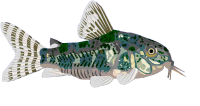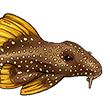| Scientific Name | Pimelodus albofasciatus Mees, 1974 |
| Common Names | White Line Pim Weißstreifen Antennenwels (Germany) |
| Type Locality | Sipaliwini, Suriname. |
| Pronunciation | pim ee LOW duss - al BOW fas sea at uss |
| Etymology | pimele, fat; –odes, having the form of, i.e., fatty, referring to their adipose fins (at the time, this was a catch-all genus for many catfish species, most of which possess a “fatty” or adipose fin) [note: many online references report that –odes is derived from odous, meaning teeth, but this is incorrect]. This specific epithet refers to its white(albus=white) lines(fascio,-atus=lines, stripes). |
| Size | 250mm or 9.8" SL. Find near, nearer or same sized spp. |
| Identification | A variable species in terms of patterning and is similar to P. maculatus but has a pronounced silvery white stripe which runs the length of the lateral line. |
| Sexing | Not known. |
| Distribution | South America: Amazon, Orinoco, upper Corantijn and Sipaliwini River basins. Amazon (click on these areas to find other species found there) Orinoco (click on these areas to find other species found there) Guyana Waters, Coastal Rivers of Guyanas, Suriname Coastal Rivers, Corintijns, Upper Corentijns (click on these areas to find other species found there) Guyana Waters, Coastal Rivers of Guyanas, Suriname Coastal Rivers, Corintijns, Sipaliwini (click on these areas to find other species found there) Login to view the map. |
| IUCN Red List Category | Least Concern , range map and more is available on the IUCN species page. Last assessed 2020. |
| pH | 5.8 - 7.2 |
| Temperature | 22.0-25.0°C or 71.6-77°F (Show species within this range) |
| Other Parameters | Undemanding in terms of water quality. |
| Feeding | An unfussy omnivore. Most prepared foods are taken and the fish will happily gorge itself on live or frozen foods. Bloodworm induces a feeding frenzy and is good for acclimatizing new, smaller acquisitions. The fish will eat huge amounts in one day, its belly swelling to resemble a marble and can comfortably live off this for up to a week. User data. |
| Furniture | These fish will be considerably more active if given lots of cover at the sides of the aquarium that they can dart into when spooked. Floating plants are also a good idea as water current is unimportant. |
| Compatibility | Peaceful but will eat smaller fishes. |
| Suggested Tankmates | Larger active fish such as tetras, most barbs and gouramis. They can also be kept in groups but do not suffer from being kept singly. Angelfish and other ''graceful'' fish are sometimes bothered by this species' barbels particularly during "lights-out". |
| Breeding | Unreported in the aquarium. |
| Breeding Reports | There is no breeding report. |
| Reference | Zoologische Verhandelingen (Leiden) No. 132; 137, Pl. 4. |
| Registered Keepers | There are 16 registered keepers, view all "my cats" data. |
| Wishlists | Love this species? Click the heart to add it to your wish list. There is no wish to keep this species. |
| Spotters | Spotted this species somewhere? Click the binoculars! There are 2 records of this fish being seen, view them all. |
| Forum BBCode | |
| Search for P. albofasciatus | |
| Look up P. albofasciatus on AquaticRepublic.com | |
 | Look up P. albofasciatus on Fishbase |
 | Look up P. albofasciatus on Encyclopedia of Life |
 | Look up P. albofasciatus on Global Biodiversity Information Facility |
| LFS label creator ARN ref:1.15.101.346 | |
| Last Update | 2025 Jan 02 01:38 (species record created: 2001 Apr 22 00:00) |





/siluriformes/pimelodidae/pimelodus/albofasciatus/1.jpg)
/siluriformes/pimelodidae/pimelodus/albofasciatus/2.jpg)